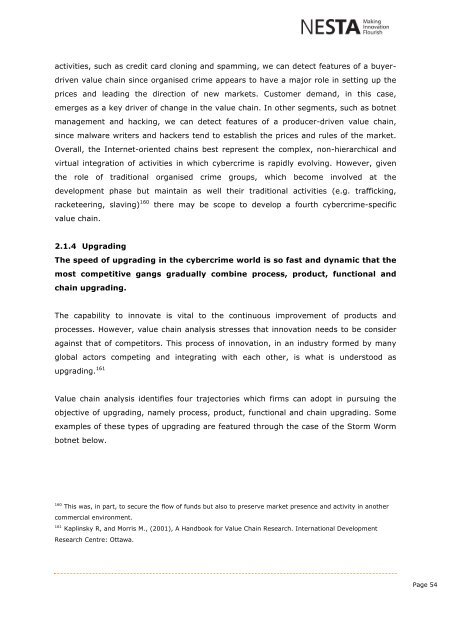NESTA Crime Online - University of Brighton Repository
NESTA Crime Online - University of Brighton Repository
NESTA Crime Online - University of Brighton Repository
Create successful ePaper yourself
Turn your PDF publications into a flip-book with our unique Google optimized e-Paper software.
activities, such as credit card cloning and spamming, we can detect features <strong>of</strong> a buyer-<br />
driven value chain since organised crime appears to have a major role in setting up the<br />
prices and leading the direction <strong>of</strong> new markets. Customer demand, in this case,<br />
emerges as a key driver <strong>of</strong> change in the value chain. In other segments, such as botnet<br />
management and hacking, we can detect features <strong>of</strong> a producer-driven value chain,<br />
since malware writers and hackers tend to establish the prices and rules <strong>of</strong> the market.<br />
Overall, the Internet-oriented chains best represent the complex, non-hierarchical and<br />
virtual integration <strong>of</strong> activities in which cybercrime is rapidly evolving. However, given<br />
the role <strong>of</strong> traditional organised crime groups, which become involved at the<br />
development phase but maintain as well their traditional activities (e.g. trafficking,<br />
racketeering, slaving) 160 there may be scope to develop a fourth cybercrime-specific<br />
value chain.<br />
2.1.4 Upgrading<br />
The speed <strong>of</strong> upgrading in the cybercrime world is so fast and dynamic that the<br />
most competitive gangs gradually combine process, product, functional and<br />
chain upgrading.<br />
The capability to innovate is vital to the continuous improvement <strong>of</strong> products and<br />
processes. However, value chain analysis stresses that innovation needs to be consider<br />
against that <strong>of</strong> competitors. This process <strong>of</strong> innovation, in an industry formed by many<br />
global actors competing and integrating with each other, is what is understood as<br />
upgrading. 161<br />
Value chain analysis identifies four trajectories which firms can adopt in pursuing the<br />
objective <strong>of</strong> upgrading, namely process, product, functional and chain upgrading. Some<br />
examples <strong>of</strong> these types <strong>of</strong> upgrading are featured through the case <strong>of</strong> the Storm Worm<br />
botnet below.<br />
160 This was, in part, to secure the flow <strong>of</strong> funds but also to preserve market presence and activity in another<br />
commercial environment.<br />
161 Kaplinsky R, and Morris M., (2001), A Handbook for Value Chain Research. International Development<br />
Research Centre: Ottawa.<br />
Page 54
















